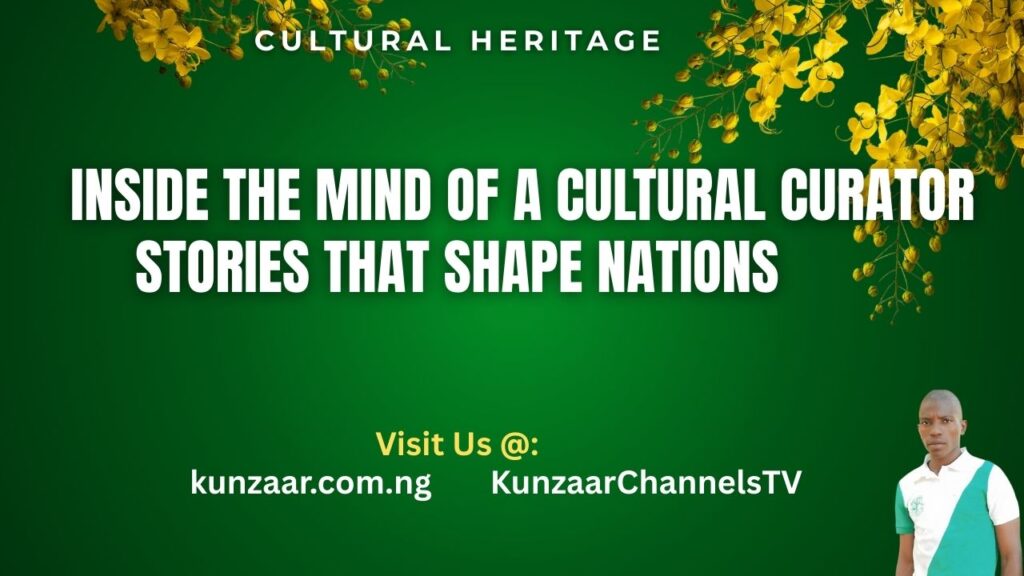Introduction
What shapes the identity of a nation? Is it its flag, anthem, or borders? Or is it the stories—told through art, language, fashion, rituals, and memory—that give a people their meaning?
At the heart of these stories are cultural curators—those unique individuals who preserve, interpret, and transmit the legacy of a people. Their work ensures that cultural heritage is not only remembered but remains alive and relevant across generations without any threat whatsoever from modernization to globalization.
Let’s step into the mind of a cultural curator and explore how they shape nations’ cultures through storytelling, symbols, and preservation of our cultural heritage.
Who Is a Cultural Curator?
A cultural curator is more than a museum worker or heritage manager. They are:
- Storytellers who shape how history is remembered.
- Guardians of traditional knowledge, artifacts, and practices.
- Translators of ancient values into modern understanding.
- Mediators between the past and the future.
Also Read: The History of Malagasy Tribe of Madagascar
They work in museums, libraries, archives, cultural centers, universities—and even social media platforms—telling stories that influence how people view themselves and others when it comes to culture?
How Cultural Curators Shape National Identity?
1. Preserving Cultural Memory
Cultural curators collect and conserve items like:
- Traditional clothing
- Historic manuscripts
- Sacred instruments
- Oral stories and folk tales
These materials remind a nation of where it came from—its roots, struggles, victories, and turning points.
A curator preserving ancient drum rhythms is ensuring that a forgotten people still have a voice in this modern time. Which we are now doing so today in this post.
2. Telling Stories That Matter
Curators select which stories are told and how they’re told. Through exhibits, documentaries, podcasts, or performances, they can:
- Challenge colonial narratives
- Promote indigenous knowledge
- Highlight underrepresented communities
- Inspire national unity
Their storytelling is intentional. It isn’t just about displaying artifacts—it’s about giving meaning and context to history.
3. Reviving Lost Traditions
Many curators actively revive dying languages, ceremonial dances, or festivals through research, documentation, and public education.
This revival:
- Strengthens cultural pride
- Educates youth
- Boosts tourism
- Rebuilds fractured identities
For instance, in Northern Nigeria, cultural curators play a major role in keeping oral histories and local languages like Sayawa (Zaar), Tarok, Bajju, Idoma, Tiv, Igala, Goemai, Zarma, or Mada alive.
4. Bridging Generations
Cultural curators are bridges between the elders and the youth because:
- They digitize ancient records for a modern audience.
- They host exhibitions that speak to young people.
- They create learning spaces where the old and new interact.
Some cultures don’t have records of their stories until the coming of the social media. This helps nations maintain a cultural continuum—a sense that their past still walks with them today.
Inside Their Daily Work
A cultural curator may:
- Interview tribal elders
- Translate traditional chants
- Design exhibits about pre-colonial kingdoms
- Create multimedia storytelling projects
- Consult on cultural policy or education
Their work combines scholarship, creativity, and diplomacy.
In the Digital Age
Today’s cultural curator is also online:
- Posting archival photos on Instagram and Facebook
- Telling folklore on YouTube
- Creating virtual museum tours
- Hosting webinars on African literature or indigenous rights
Digital platforms have become new museums—places where national stories are told in real time to a global audience. That makes others to know that some cultures exist.
Final Thoughts
Why This Matters?
Without cultural curators, nations risk forgetting who they are. They risk losing:
- Indigenous languages
- Ancient wisdom
- Spiritual traditions
- Local heroes
- Stories that bind families and clans
A cultural curator doesn’t just protect the past. They shape the identity, resilience, and future of nations.
You Can Also Read: Understanding Fractions Made Easy
Key Takeaways For This
- Cultural curators preserve, interpret, and present stories that define national identity.
- Their work includes oral history, traditional art, museum exhibits, and digital storytelling.
- They revive forgotten traditions and connect the past with the future.
In a globalized world, curators help nations stay rooted in their cultural uniqueness.
Action
How do you stay connected to your cultural identity? You can also become a cultural curator by sharing a story of a culture using #MyCulturalCode and also comment below so as to keep our cultural heritage alive! Let built ties through cultures. Also Visit our cultural curator through YouTube Channel: KunzaarChannelsTV through @kunzaarchannelstv to watch the best of cultural heritage.

